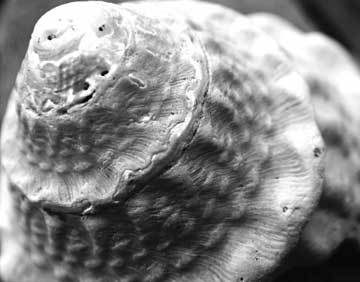
Jewelry, tides, language:
things that shine.
What is description, after all,
but encoded desire?Mark Doty
A nor’easter smacked into Cape Ann last night, and this morning the wrack’s dark line lies tangled and heaped. Hundreds of shells have settled sideways and tilted on the beach, half in, half out, sand-dribbled, seaweed-draped, partially rinsed. On the outside, they’re a riot of spires and pinpricks, ribbed turbans and knobby cones. Ivory, copper, pinkish, twisted, scalloped, hinged.
In the cool and sunny aftermath of the storm, I squat down, close my eyes, scoop them up, and let them cascade through my fingers. Nothing whole seems to make it to the beach, the ocean itself being the great agent of breakage. So much of what washes ashore here has been pummeled by waves, dragged on gritty bottoms. The pressure of sea overhead can cause fragile clams to shatter, unhinge and crack open. Something about this enlivens me.
Inside, the shells are emptied or crammed full of the creatures that created them: waved whelk and wentletraps, oysters and scallops, some of them dead, others trying to re-water themselves or dry out a bit in the sand. Their narratives do nothing to distinguish them. Eat, protect, reproduce, and die: what else is new? This, the language of how they do it: scuttle and siphon, burrow and spit, scissor-step and sink.
When I open my eyes, the ocean seems to demand too much. At another time in my life, I might have responded–raised a sail, plied my oars, at least considered the lure of infinity. If the sea, after all, has any constant call that can also sound like taunting, it goes like this: come in, come in. But this is the cold north Atlantic and I’m older and I won’t and besides, if I did, I’d be out there immersed in the lives of these cracked-open things I’d rather look at underfoot. It’s not that I’m tired of desire; I just want to make sure it’s my own.
Wherever the sea—like others’ wants—begins to encroach, there’s evidence of scrimmage. Here, crab claws and feathers, fraying rope and shredded kelp, an upended dory and a man I avoid because he wants to talk again about shamanic journeys. I’m less interested at the moment in where things are going, more in what happens if they come apart.
Without its creature of needs, an emptied shell allows me to see the curve of a marble-like entrance, to note that light diminishes as it travels up the coil. I can even stick a finger in. Close to my left foot lies the upper valve of a jingle shell; the underside of its shallow dome gleams silvery yellow and translucent, a scraping of mica. Here on the boundary between broken and whole, insides glisten, and my current favorite, a blue mussel edged in violet, lies opened against a cockle shell whose interior is the color of yolk.
Barbara Hurd is is the author of Entering the Stone: On Caves and Feeling Through the Dark, a Library Journal Best Natural History Book of the Year (Houghton Mifflin, 2003), The Singer’s Temple (Bright Hill Press, 2003), Stirring the Mud: On Swamps, Bogs, and Human Imagination, a Los Angeles Times Best Book of 2001 (Beacon 2001), and Objects in this Mirror (Artscape, 1994). Her essays have appeared in numerous journals including Best American Essays 1999, Best American Essays 2001, The Yale Review, The Georgia Review, Orion, Audubon, and others. The recipient of a 2002 NEA Fellowship for Creative Nonfiction, winner of the Sierra Club’s National Nature Writing Award and a 2004 Pushcart Prize, she teaches creative writing at Frostburg State University in Frostburg, MD, and in the Stonecoast MFA program at the University of Southern Maine. She lives in Frostburg, MD, with her husband, the poet Stephen Dunn.
